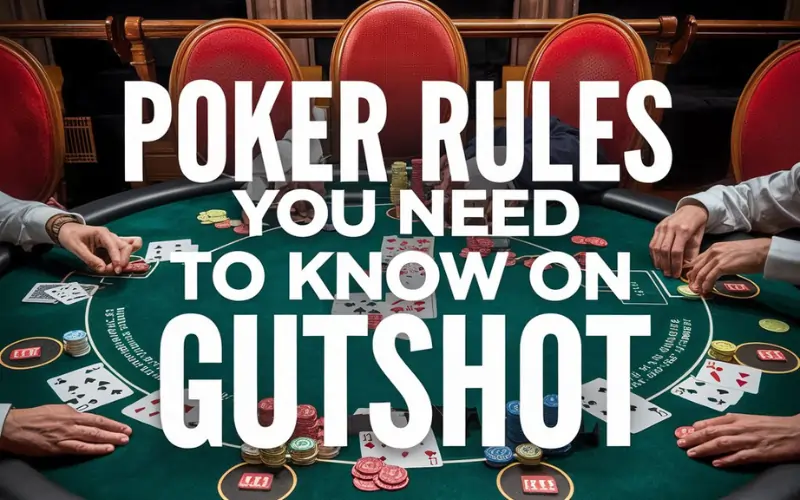Poker is one of the most popular card games worldwide, enjoyed by millions for its blend of skill, strategy, and luck. While it may look complex to the uninitiated, understanding poker rules is the first step towards building confidence and improving your gameplay. Whether you’re new to poker or looking to brush up on your basics, learning the rules thoroughly can set you on a path to success. Gutshot, a leading online poker platform, offers an ideal environment to practice these rules and grow as a player.
In this guide, we’ll break down the essential poker rules you need to know to play confidently on Gutshot. We’ll cover the different types of poker, key terminology, the basic flow of the game, and some practical tips to help you start strong.
Why Knowing Poker Rules is Essential
Poker is a game where understanding the rules and strategies makes all the difference between winning and losing. Knowing the poker rules allows you to play strategically, make better decisions, and read your opponents’ moves with confidence. Each poker variation has specific rules, but all share common elements that are essential to grasp before diving in.
Gutshot provides a range of poker games, from Texas Hold’em to Omaha, each requiring a clear understanding of the rules. With a strong foundation, you’ll find the game more enjoyable and be better prepared to take on experienced players.

Types of Poker Games on Gutshot
Before we delve into the core poker rules, it’s helpful to understand the two main types of poker games you’ll find on Gutshot: Texas Hold’em and Omaha. Both have their unique rules and play styles, though they share common elements. Gutshot’s platform allows you to switch between these games, giving you the flexibility to play the style that suits you best.
1. Texas Hold’em
Texas Hold’em is the most popular form of poker and is played worldwide, especially in tournaments. Each player receives two private cards, known as hole cards, and five community cards are placed face-up in the center of the table. The objective is to create the best five-card hand by combining the hole cards with the community cards.
2. Omaha
In Omaha, each player is dealt four private cards instead of two, and they must use exactly two of those cards combined with three of the five community cards to make their hand. This adds an extra layer of strategy and complexity compared to Texas Hold’em.
Both games require a strong understanding of poker rules, as each move counts and strategy is key. Now, let’s dive into the fundamental rules you need to know to play confidently.
Basic Poker Rules to Start Playing with Confidence
Understanding these core poker rules will give you a solid foundation to begin playing on Gutshot. Once you have these basics down, you can focus on refining your strategy and improving your gameplay.
1. Poker Hands Ranking
A crucial part of poker rules is knowing the different poker hands and their rankings. Winning in poker often comes down to who has the best hand, so memorizing these rankings is essential. Here’s a quick overview, from the highest to the lowest-ranking hand:
- Royal Flush: A hand consisting of A, K, Q, J, and 10, all in the same suit.
- Straight Flush: A sequence of five consecutive cards, all in the same suit.
- Four of a Kind: A hand with four cards of the same rank.
- Full House: A hand containing three cards of one rank and two cards of a different rank.
- Flush: A hand with any five cards of the same suit, not in consecutive order.
- Straight: A hand with five consecutive cards of varying suits.
- Three of a Kind: A hand with three cards of the same rank.
- Two Pair: A hand with two cards of one rank and another two cards of a different rank.
- One Pair: A hand with two cards of the same rank.
- High Card: If no other hand is formed, the hand with the highest card wins.
In Texas Hold’em and Omaha, understanding hand rankings will help you make better decisions about when to fold, call, or raise. Knowing the strength of your hand relative to others is a fundamental poker skill.
2. The Betting Rounds
Poker is divided into betting rounds, and understanding when and how to bet is central to the game. Each betting round presents an opportunity to assess your hand and the potential hands of your opponents. Here’s a breakdown of the betting rounds in Texas Hold’em and Omaha:
- Pre-Flop: After each player is dealt their hole cards, the first round of betting begins. Players can choose to call, raise, or fold based on their cards and position.
- The Flop: The dealer reveals three community cards face-up on the table, followed by a new round of betting. Now that players have more information, they can better assess the strength of their hands.
- The Turn: A fourth community card is dealt face-up, followed by an additional round of betting. The action tends to intensify as players either solidify their hands or fold based on their chances.
- The River: The fifth and final community card is dealt face-up, leading to the final round of betting.
- Showdown: If two or more players remain after the final betting round, they reveal their cards, and the player with the highest-ranking hand wins the pot.
Each betting round has a minimum bet amount, and players can choose to bet, check, raise, or fold based on their hand strength and strategy.
3. Positions and Their Importance
One of the most crucial yet often overlooked poker rules is understanding player positions at the table. Position determines the order in which players act and is essential for strategic decision-making. Here are the main positions:
- Early Position: Players who act first in the betting round. These players have the least information about their opponents’ moves, so they should play conservatively.
- Middle Position: Players in the middle have some information about early position players’ actions but still need to be cautious.
- Late Position: These players act last and have the advantage of knowing how their opponents acted. Late position players can play a wider range of hands and bluff more effectively.
On Gutshot, mastering positional play can significantly improve your gameplay, allowing you to make well-informed decisions based on other players’ actions.
4. Betting Actions Explained
Betting is a core aspect of poker, and understanding each betting action is essential to following poker rules effectively. Here are the main betting actions you’ll encounter:
- Check: Passing the action to the next player without making a bet.
- Bet: Placing an amount into the pot, initiating a betting round.
- Call: Matching the current highest bet to stay in the round.
- Raise: Increasing the amount of the current bet, challenging other players to either call, re-raise, or fold.
- Fold: Forfeiting your cards and leaving the hand.
Betting wisely is essential for bluffing, controlling the pot size, and strategically building your winnings. On Gutshot, you can use these actions to add psychological depth to your game, challenging opponents and potentially forcing them to make mistakes.
5. Blinds and the Dealer Button
In poker, especially Texas Hold’em, blinds are forced bets that start the betting action. Understanding the purpose of blinds and the dealer button is critical to mastering poker rules:
- Small Blind (SB): The player immediately left of the dealer must post a small bet.
- Big Blind (BB): The player two seats left of the dealer posts a larger blind. The big blind is usually double the amount of the small blind.
- Dealer Button: This button moves clockwise after each hand, determining who posts the blinds and who acts last.
The blinds encourage action and create an initial pot for players to compete for, making each hand more engaging and strategic. Knowing when you’re in the blind positions on Gutshot helps you prepare for the costs associated with each round.
Additional Poker Rules and Etiquette
In addition to the basic poker rules, here are some etiquette and unwritten rules that will make you a respected player:
- Don’t Slow Roll: Deliberately delaying to reveal a strong hand in the showdown is considered poor etiquette.
- Avoid Colluding: Don’t team up with other players to gain an unfair advantage; this is against the rules and can lead to penalties.
- Be Mindful of Your Time: Avoid taking too long on every decision, as it can slow down the game and frustrate other players.
Practicing good etiquette will enhance your experience on Gutshot and create a positive gaming environment for everyone.
Tips for Mastering Poker Rules on Gutshot
- Practice Regularly: The more you play, 4rabet the more familiar and comfortable you’ll get with the rules. Gutshot’s online platform makes it easy to practice at your convenience.
- Start with Lower Stakes: Play low-stakes games to get a feel for the rules without risking too much.
- Observe Other Players: Watch how experienced players bet and react in different scenarios. This helps you understand both the rules and strategies that successful players use.
- Use Gutshot’s Tutorials: Gutshot offers tutorials and resources that guide you through the rules of each game, helping you build a strong foundation.
Conclusion: Play with Confidence on Gutshot
Mastering poker rules is the first step toward becoming a confident player on Gutshot. By understanding the different types of hands, betting rounds, positions, and essential game mechanics, you’ll be well-prepared to take on any table with ease. Gutshot provides a supportive platform where you can practice these rules, refine your strategies, and play against players of all skill levels.
Remember, poker is not just about the cards you hold but also about how well you play them. With this knowledge, you’re ready to sit at the table, apply these poker rules, and start your journey to becoming a skilled and confident poker player on Gutshot.








